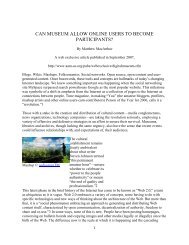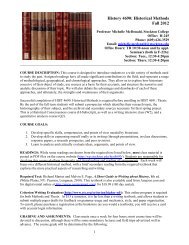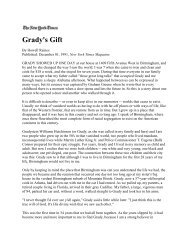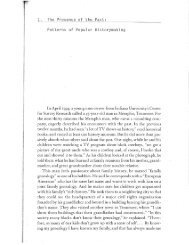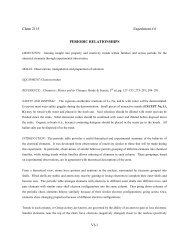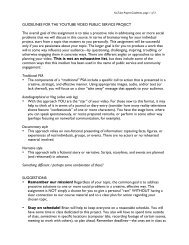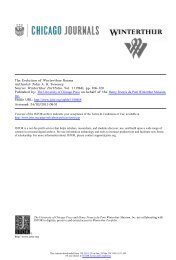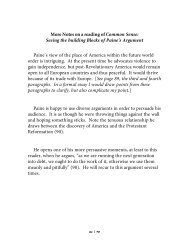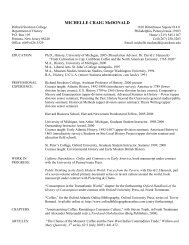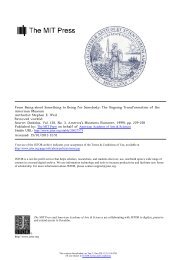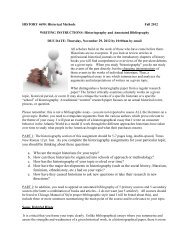What Is the Object of This Exercise? A Meandering Exploration of ...
What Is the Object of This Exercise? A Meandering Exploration of ...
What Is the Object of This Exercise? A Meandering Exploration of ...
You also want an ePaper? Increase the reach of your titles
YUMPU automatically turns print PDFs into web optimized ePapers that Google loves.
The Many Meanings <strong>of</strong> <strong>Object</strong>s in Museums 169<br />
desirable, but <strong>the</strong>ir absence is not<br />
disabling.<br />
. . ."3 In response,<br />
many museums set about creating<br />
more than one set <strong>of</strong> rules?<br />
one for accessioned objects, and ano<strong>the</strong>r for exhibitions mate<br />
rial?and began<br />
to understand that <strong>the</strong> handkable material<br />
<strong>the</strong>y used in <strong>the</strong>ir classes (<strong>the</strong>ir teaching collections) should be<br />
governed by<br />
a different set <strong>of</strong> criteria as well.<br />
Never<strong>the</strong>less, <strong>the</strong>re were <strong>of</strong>ten no easy distinctions between<br />
<strong>the</strong> handkablity <strong>of</strong> teaching collections' objects and those oth<br />
ers deserving preservation. The Boston Children's Museum<br />
loan boxes, for example, created in <strong>the</strong> 1960s, contained easy<br />
to-obtain material about Nor<strong>the</strong>ast Native Americans. But by<br />
<strong>the</strong> 1980s, <strong>the</strong> remaining material was retired from <strong>the</strong> loan<br />
boxes and accessioned into <strong>the</strong> collections because it was no<br />
longer obtainable and had become rare and valuable.<br />
Even purpose-built "environments" have, in cases such as <strong>the</strong><br />
synagogue models in <strong>the</strong> Museum <strong>of</strong> <strong>the</strong> Diaspora<br />
in Tel Aviv,<br />
become so<br />
intriguing<br />
or are <strong>of</strong> such craftsmanship that <strong>the</strong>y,<br />
decades later, become collections' objects <strong>the</strong>mselves. So, too,<br />
have <strong>the</strong> exhibitions created by distinguished artists, such as<br />
parts <strong>of</strong> Charles and Ray Eames's exhibit Ma<strong>the</strong>matical A<br />
World <strong>of</strong> Numbers and Beyond.<br />
Dioramas were <strong>of</strong>ten built for a museum exhibition hall in<br />
order to put objects (mostly animals) in context. These display<br />
techniques, which were considered a craft at <strong>the</strong> time <strong>the</strong>y were<br />
created, were<br />
occasionally <strong>of</strong> such beauty, and displayed artis<br />
tic conventions <strong>of</strong> realism (and seeming realism) so<br />
special, that<br />
today <strong>the</strong> original dioramas <strong>the</strong>mselves have become "objects,"<br />
and many are<br />
subject<br />
to<br />
preservation, accession, and special<br />
display. The definition <strong>of</strong> objects suitable for collections has,<br />
<strong>the</strong>refore, expanded<br />
to include, in<br />
special cases, material built<br />
for <strong>the</strong> museum itself.<br />
WHAT IS REAL? IS THE EXPERIENCE THE OBJECT?<br />
In <strong>the</strong> nineteenth century, some museums had and displayed<br />
sculptural plaster castings and studies. The Louvre and o<strong>the</strong>r<br />
museums had rooms devoted to copies <strong>of</strong> famous sculptures<br />
that <strong>the</strong> museum did not own. The originals ei<strong>the</strong>r remained in<br />
situ or were held by o<strong>the</strong>rs. People<br />
<strong>This</strong> content downloaded on Tue, 15 Jan 2013 12:26:43 PM<br />
All use subject to JSTOR Terms and Conditions<br />
came to see, study, and paint



